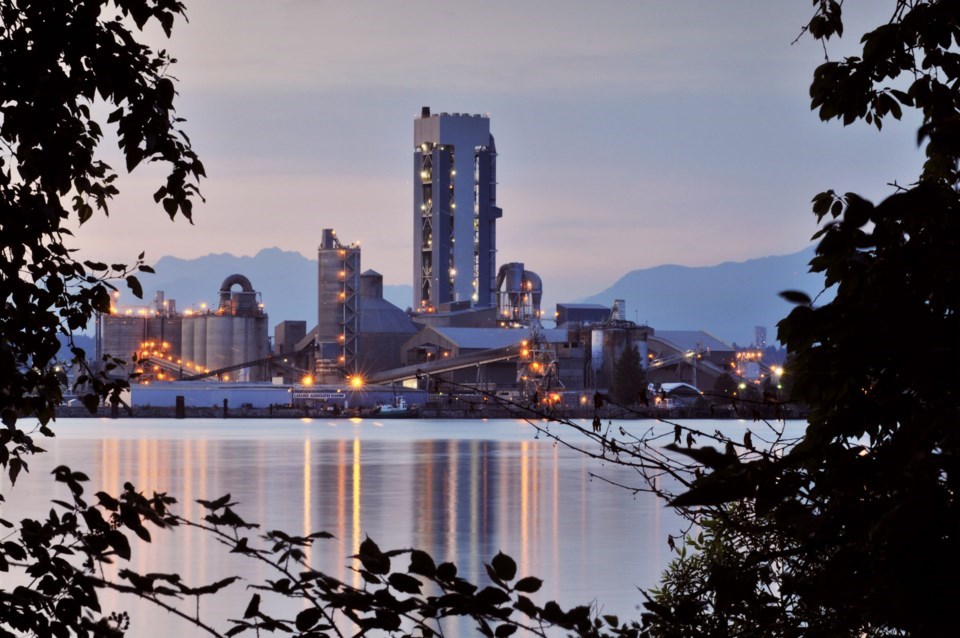Lafarge Canada Inc.’s Richmond plant is one step closer to being the first cement plant in the world to have the technology to recycle carbon emissions from its cement production.
Lafarge announced that the second phase of its Project CO2MENT, the installation of the Svante CO2 capture unit, is now complete.
While the plant will only be capturing a small percentage of the CO2 it emits daily, the technology is a step in the right direction.
The unit uses carbon capture technology to trap the CO2 – produced during the cement production and contained in its cement flue gas that’s connected to the kiln – and clean and filter it. This means the CO2 can be captured and, following the project’s next phase, re-used, according to Lafarge, creating the world’s first “full-cycle solution to capture and reuse CO2 from a cement plant.”
While the Richmond plant previously installed a low-carbon fuel system to replace the use of fossil fuels, CO2 is still created during cement production when limestone is heated in the kiln, said Jonathan Moser, Lafarge Canada’s head of environment and public affairs.
The Richmond plant will be able to capture about one tonne of CO2 per day to start, and possibly up to 200 tonnes this year.
Depending on daily production, the plant can produce up to 2,000 tonnes of CO2 a day, said Moser, and while capturing one tonne of CO2 is “just scratching the surface,” it’s important to test the technology.
“Right now, because of the carbon footprint we have at Richmond, we ultimately want to capture more than one tonne of CO2 and look to expand to go up to 50 tonnes, (which) would be the next phase of the project once we prove out this pilot phase.”
Lafarge will now work on attaching a liquefaction unit that will allow for more flexible use of the CO2, said Moser. Once that’s installed – likely within the next few months – the plant will be able to start re-using the captured CO2.
Some of the captured CO2 will be re-used on site, for example, in water treatment and fire suppression. However, the goal is to be able to re-invest it into building materials, said Moser. Lafarge is also looking at the “CO2 marketplace” to see where else it could be used, for example, for medical or industrial purposes or food-grade greenhouses.
Recapture technology a ‘great help’
If Lafarge or other cement makers are able to come up with an effective technology, it could make an “enormous dent” in the CO2 emitted from that industry in the coming years, said Paul Richard, an instructor with, and retired chair of, Kwantlen Polytechnic University’s environmental protection program.
“Given that making cement, making concrete, is one of the larger emitters of CO2 and therefore of greenhouse gas throughout the world, anything that’s effective at capturing that part of CO2 is a great help, even if it’s only ever usable for concrete-making,” he said.
“There’s never a silver bullet, there’s never one thing that can be done to get us out of our (climate) predicament, but every little bit, so to speak, helps in that respect.”
While other industries such as oil are also working on carbon capture and storage technologies, said Richard, those projects are capital-intensive and it hasn’t been demonstrated that they’re practical.
That’s not to say that the development of those technologies should be discouraged – in fact, in the case of Lafarge, they “should be encouraged,” he said.
“I think it’s a matter of where we should put money to get the best effect for any expenditure towards addressing climate change. In terms of carbon storage in concrete, I think that one is promising; other forms of (carbon capture and storage), though, the proof is not in the pudding, to put it this way.”
However, Richard said he would also like to see funding put towards “lower tech” programs, for example, helping farmers increase the organic matter content of their soils, as soils in good shape can “suck up CO2 from the air very effectively.”
Lafarge partnered with Svante, which produces the carbon-capture technology, as well as Total, an energy company that supplies oil, natural gas and low-carbon electricity for Project CO2MENT.
The company will also be developing a business case review to see if the technology could be expanded to other Lafarge plants around the world.



